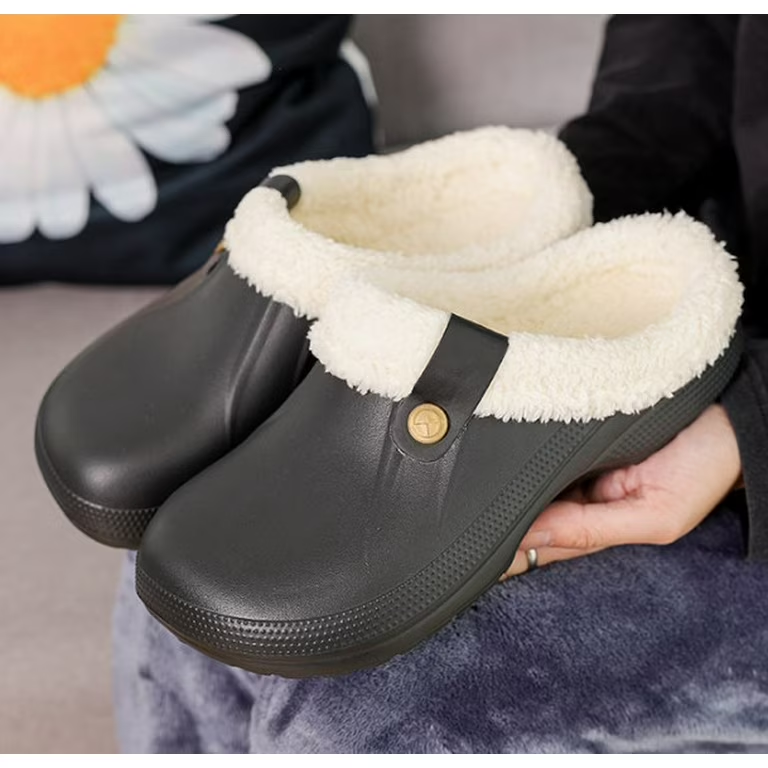As a buyer for your business, you want to make sure you get the right product. When it comes to the footwear industry, specifically slippers for outdoor use, you want to make sure you’re buying what your market wants and what will give you the most value. This guide is for B2B buyers like you who want to know how to buy outdoor slippers from manufacturers.

1. Current Outdoor Slipper Market
The outdoor slipper market is growing fast. As people’s lifestyles become more diverse, they want casual, functional footwear they can wear outside. They want to wear slippers outside to walk in the garden, run errands, or lounge by the pool. They want slippers with features that make them more durable and comfortable for outdoor use.
Outdoor slippers are different from indoor slippers because they’re made with different materials, they’re more durable, and they have features that make them perform better outside. They may have rugged soles, water-resistant materials, and more support to handle the outdoor environment.

2. Key Trends in Outdoor Slippers
Understanding trends in the market will help you choose products that are in demand and meet your customers’ needs. Here are some trends to keep in mind:
Sustainability
As people become more eco-conscious around the world, they’re looking for products that are environmentally friendly. Outdoor slippers made from recycled materials, natural fibers, or biodegradable products are becoming more popular.
Hybrid Designs
Many slippers are now designed to be used both indoors and outdoors. This adds versatility to the product and makes it more appealing to customers who want to get more use out of their purchase.
Comfort & Ergonomics
Features like memory foam, arch support, and breathable fabrics are becoming more important. People are more focused on their health and well-being, so they want outdoor slippers that are comfortable.
All-Weather Use
Outdoor slippers that protect your feet from things like water, cold, or heat are becoming more popular. People want water-resistant slippers or slippers that keep their feet warm when it’s cold outside.

3. Factors to Consider When Sourcing Outdoor Slippers
As a buyer, there are several key things to consider when sourcing outdoor slippers. These things will help you make sure your supplier meets your quality standards and help you build a strong brand offering for your business. Here’s what you need to know:
a. Material
The material used in your outdoor slippers affects how durable and comfortable they are. Some of the materials used in outdoor slippers include:
- Rubber: Rubber is great for soles because it provides good traction, durability, and water resistance. Look for outdoor slippers with non-slip rubber soles.
- EVA Foam: EVA foam is lightweight and flexible. It’s often used for cushioning in slippers because it provides comfort without adding a lot of weight.
- Neoprene: Neoprene is a waterproof material that’s often used in outdoor footwear. It’s a good option if you want water-resistant slippers.ers.
- Leather and Suede: Leather and suede are high-quality materials that are very durable. However, they may not be suitable for wet conditions unless they’re treated properly.

b. Design Features
Pay attention to the key design features that are important for outdoor use:
- Grip and Traction: When you’re wearing slippers outside, you want to make sure you don’t slip on wet or uneven surfaces. Look for non-slip soles on your outdoor slippers.
- Breathability: You want your outdoor slippers to be breathable so your feet stay dry and comfortable, especially if you live in a warmer climate. Look for slippers made of mesh or perforated leather to help air flow.
- Waterproofing: If you’re going to wear your slippers outside by the pool or in the garden, you want them to be waterproof or water-resistant. Look for slippers made of rubber or treated fabrics.
- Arch Support and Cushioning: Good outdoor slippers will have good arch support and cushioning to keep your feet comfortable during long walks or when you’re walking on rough terrain. Memory foam insoles and padded footbeds are popular choices.
c. Sizing and Fit
Make sure the outdoor slippers you’re sourcing come in a wide range of sizes and fit well. People tend to wear outdoor slippers for longer periods of time, so comfort is important. Offer half-sizes, adjustable straps, or slippers made of elastic materials to accommodate more people.
4. Finding Reliable Suppliers
Finding reliable manufacturers is important so you can get quality products delivered on time. Here’s how to find a good supplier:
a. Supplier Experience
Look for suppliers who have a lot of experience making outdoor footwear. They’ll understand what’s needed to make a good outdoor slipper that’s durable and comfortable.
b. Quality Assurance
You want to make sure the manufacturer has a good quality control process. Ask them to explain their quality assurance process. Ask for samples of their products so you can see the quality of the build, materials, and design.

c. Certifications
Find out if the supplier has any certifications related to environmental practices (like ISO 14001), quality management (like ISO 9001), or ethical labor practices. Certifications are a good way to ensure quality, safety, and compliance with international standards.
d. Production Capacity
Make sure the supplier can handle the volume of orders you want to place, especially if you plan to buy in bulk. You want to make sure they can scale production up or down depending on demand to keep your supply chain running smoothly.
e. Lead Times
Make sure the supplier can deliver your products when you need them. Find out how long it takes them to produce your order and how long it takes them to ship it to you. You want to make sure their lead times work for your business. If they can’t deliver your products on time, it can affect your inventory levels and your customers’ satisfaction.

5. Cost Considerations
While price is important, you don’t want to sacrifice quality. You need to find the right balance between price and quality when you’re sourcing outdoor slippers for the B2B market. Here are some ways to manage your costs without sacrificing quality:
- Bulk Purchasing:Many suppliers will give you a discount if you buy in bulk. This can help you reduce the overall cost per unit.
- Shipping Options: Talk to your suppliers about shipping. Some suppliers may offer better shipping rates or faster shipping times if you order from them regularly.
- Supplier Negotiations: Don’t be afraid to negotiate with your suppliers. You can negotiate the price, payment terms, or lead times. If you’re going to be a long-term customer, you may be able to get better pricing or more flexible payment terms.
6. Customization Options
Outdoor slippers are a great product to customize. This is a big selling point for retailers or hospitality businesses. Here are some things to think about:
- Branding: Many manufacturers will let you put your logo on the slippers or create custom designs for your business.
- Color and Material Choices: You may be able to choose different colors, materials, or styles based on what you think your customers will want. The more variety you can offer, the more people you can sell to.

- Specialized Features: You can customize features like waterproofing, insulation, or anti-slip soles based on the outdoor environments where people will be wearing the slippers.
7. Sustainability and Ethical Sourcing
More and more B2B buyers are looking for suppliers who can help them meet their sustainability and ethical sourcing goals. Here’s how you can make sure your slipper sourcing meets these standards:
- Eco-Friendly Materials: Look for suppliers who use recycled materials or who source their materials from sustainable sources. For example, you might look for slippers made from organic cotton, jute, or natural rubber.
- Ethical Manufacturing: Make sure your suppliers follow fair labor practices and operate under ethical working conditions. This will help your brand resonate with consumers who care about the environment and social issues.
- Certifications: Look for certifications like Fair Trade, Global Organic Textile Standard (GOTS), or Bluesign to verify that the slippers are sustainable.

8. Supplier Partnerships and Long-Term Relationships
Building long-term relationships with your suppliers is important for your B2B business. When you have a good relationship with your suppliers, you can get better pricing, faster lead times, and better communication. Be proactive in your communication with your suppliers. Consider visiting their manufacturing sites to build trust and make sure they’re making a quality product.
9. Distribution and Inventory Management
You need to have a good system in place for distributing your slippers and managing your inventory. Look for suppliers who offer drop-shipping services or who have distribution centers in your area. This can help you streamline your logistics and reduce your shipping costs.
To optimize your inventory management, put in a good tracking system that allows you to see what you have in stock at any given time. You can use automated systems to help you not overbuy or underbuy.
10. Conclusion
The outdoor slipper market is a great opportunity. Source good, high-quality, durable, and stylish products. Understand the market trends. Build relationships with suppliers you can trust. Offer innovative and sustainable product choices. Stand out in the B2B market.
By following these tips, you’ll be able to make better decisions that make you more money and help you deliver great products to your customers.


